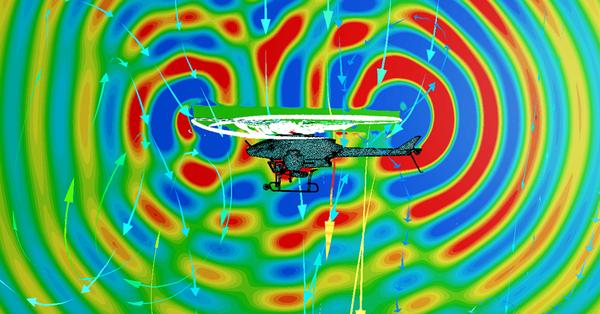Yamaha Motor Visualizes Helicopter...
04
01
Yamaha Motor Visualizes Helicopter Sounds, Its Method and Aims
Analysis diagram visualizing the fluid sound source of an industrial unmanned helicopter

Visualization of the flying sound of the helicopter "baba baba...". Yamaha Motor Co., Ltd. uses coupled analysis, an analysis method that integrates multiple simulations such as acoustic, fluid, and structural analysis, to make it possible to see the flight sound of industrial unmanned helicopters, which is a mixture of the engine sound and rotor flow sound. turned into The aim is to elucidate the true nature of the rotor's flow noise and improve the quietness during operation. Industrial-use unmanned helicopters are used in a wide range of applications, including transportation, observation, and research, in addition to agricultural sites such as aerial spraying of pesticides. If quietness can be improved, it will lead to a reduction in the burden on workers during the hot summer months. In addition, the field of application is expected to expand as it becomes easier to use even on sites near residential areas. Using MSC's analysis tool "Nastran", we are working to clarify the flow noise. It was selected as the first place in a contest of usage examples for users of this tool, and won a supplementary prize of $ 1,000 (about 115,000 yen). A design manager at Yamaha Motor's UMS Business Promotion Department, who is in charge of unmanned helicopters, enthusiastically said, "We will use this as encouragement to develop even quieter and more friendly products." We have a track record of reducing noise by 3 decibels by adopting a 4-stroke engine for unmanned helicopters, but we aim to further reduce noise. In addition to product development, knowledge from coupled analysis may lead to learning how to fly quietly. In collaboration with advanced development, manufacturing technology, and manufacturing departments, the company plans to use analysis technology to innovate the development process and transform the basic structure of products.


![[Kill personally developed games] Top class in app history! Too beautiful water puzzle "a [Q] ua" | Famitsu App for smartphone game information [Kill personally developed games] Top class in app history! Too beautiful water puzzle "a [Q] ua" | Famitsu App for smartphone game information](https://website-google-hk.oss-cn-hongkong.aliyuncs.com/drawing/article_results_7/2022/3/3/66755df992ff2d2b1e1ab43844ef9f88_0.jpeg)





![[Latest in 2021] 10 recommended seat covers for cars!If you want to improve the texture and functionality of the car, choose the mounting type and material. [Latest in 2021] 10 recommended seat covers for cars!If you want to improve the texture and functionality of the car, choose the mounting type and material.](https://website-google-hk.oss-cn-hongkong.aliyuncs.com/drawing/article_results_7/2022/3/3/e5b44589e77141f3a633189165fb6f60_0.jpeg)